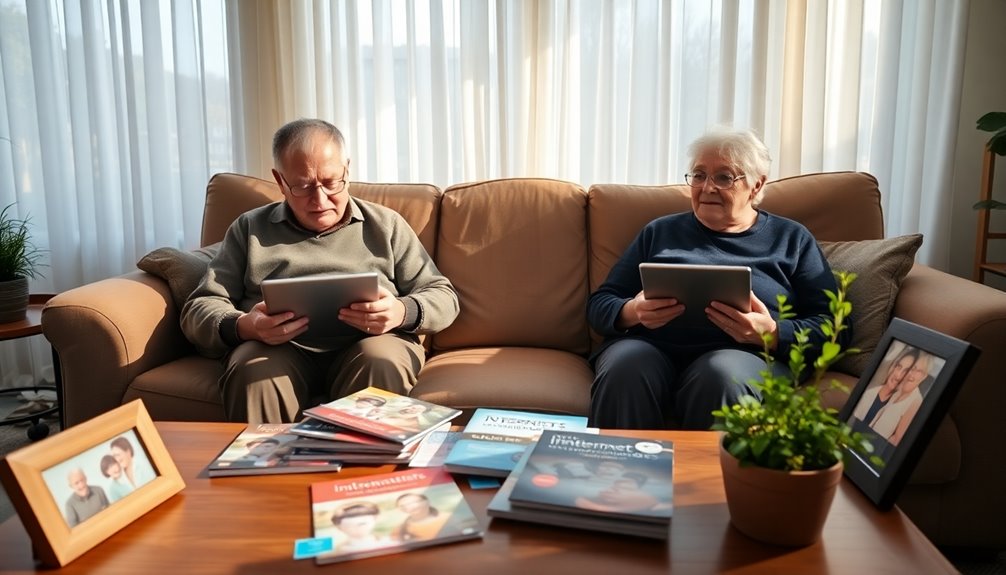I created an instant social life by jumping into Meetup, a platform that connects folks with similar interests. My first experience was filled with excitement and nerves, but I found friendly participants enthusiastic to chat. I explored groups that aligned with my passions and even started my own, which helped me bond with others. Regular meetups transformed acquaintances into true friends, and I loved the diverse activities, including health and fitness events. Stepping out of my comfort zone opened up new friendships. Keep following my journey, and you'll discover more about how Meetup can enrich your social experience.
Key Takeaways
- Joined diverse Meetup groups to explore various interests and connect with like-minded individuals, enhancing social interactions.
- Attended events consistently, fostering relationships that transformed acquaintances into lasting friendships.
- Engaged in wellness activities like Chair Yoga and Fit Fusion, promoting health while building a supportive community.
- Organized and planned meetups to create welcoming environments, encouraging member participation and input.
- Embraced stepping outside my comfort zone, leading to unexpected connections and enriching personal experiences.
Overview of Meetup.com
Meetup.com connects people with shared interests, making it easier to build a social life. I discovered this platform after feeling a bit isolated in my new city.
Founded in New York City after 9/11, it aimed to foster offline communities where diverse groups could gather. I love that I can search for groups based on my zip code and interests, making it simple to find local meetups.
Membership is free, though organizers pay a small monthly fee. I appreciate how groups meet in various venues, encouraging intergenerational interaction.
The user interface is straightforward, allowing me to receive notifications and messages easily. Overall, Meetup.com has been a game-changer for connecting with others who share my passions.
My First Meetup Experience
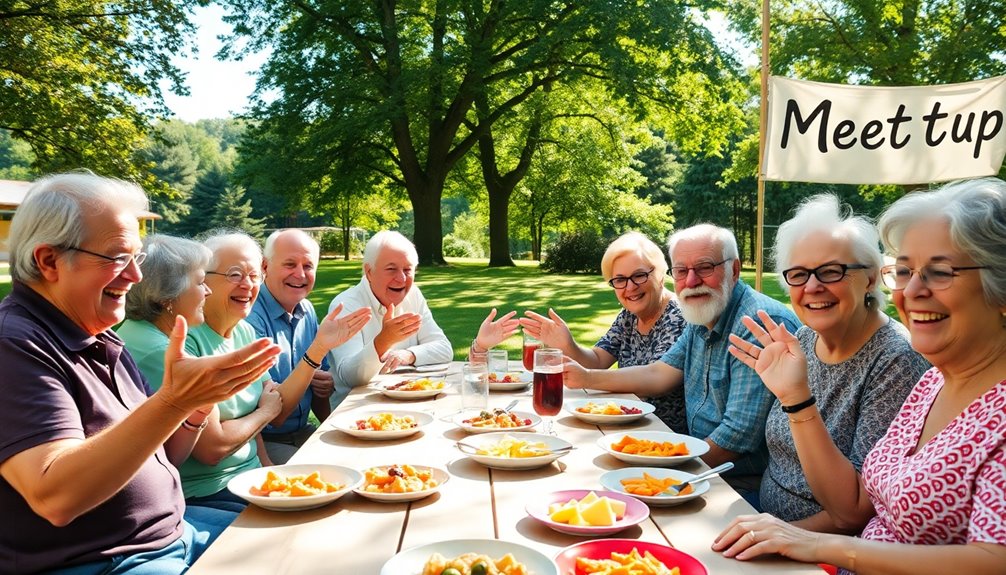
Attending my first Meetup felt like stepping into the unknown, a mix of excitement and nervousness swirling inside me.
I arrived at a local coffee shop, scanning the room for familiar faces. I spotted a handful of people gathered around a table, engaged in conversation. Gathering my courage, I approached them and introduced myself. To my surprise, they welcomed me warmly, and we quickly fell into easy chatter. Engagement in communities can significantly enhance the chances of forming lasting connections.
However, I noticed the structure felt a bit rigid, making it hard to connect deeply. Despite this, I left feeling grateful for the experience and enthusiastic to try again. That first Meetup taught me that stepping outside my comfort zone could lead to new friendships, even if it didn't go exactly as I'd envisioned. Building connections is often enhanced by active listening, as it demonstrates genuine interest and fosters deeper conversations.
Finding the Right Groups
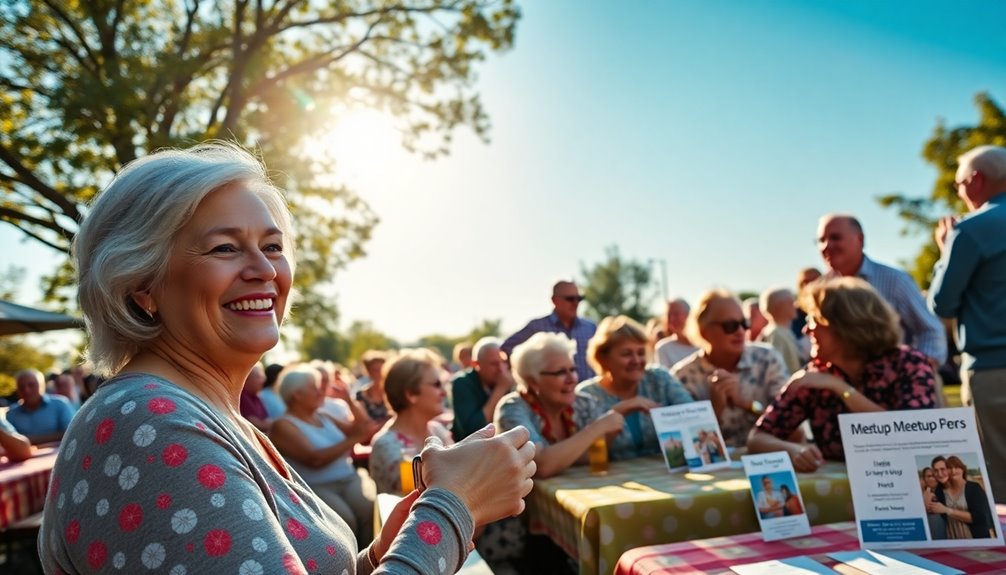
After that initial Meetup experience, I realized that finding the right groups can greatly enhance your social interactions.
I started exploring different categories and interests, using the search function to narrow down options by zip code and distance. It was essential to check activity levels, as groups with recent meetups often indicate engaged members. Additionally, staying in a high vibrational energy can enhance social connections and make interactions more enjoyable. Practicing mindfulness techniques can also help you remain present during social interactions, allowing for deeper connections. Engaging in self-care routines before meetups can further elevate your mood and energy, making you more approachable. A supportive social environment can foster emotional regulation, enhancing your ability to connect with others.
I also paid attention to member reviews, which offered insights into the group dynamics. Don't hesitate to reach out to organizers if you need approval to join.
I found it helpful to keep an open mind about various activities, even those outside my usual interests. This approach led me to unexpected friendships and enriching experiences that truly broadened my social circle. Moreover, embracing a growth mindset can help you navigate new social situations with confidence and resilience.
Creating a New Meetup Group
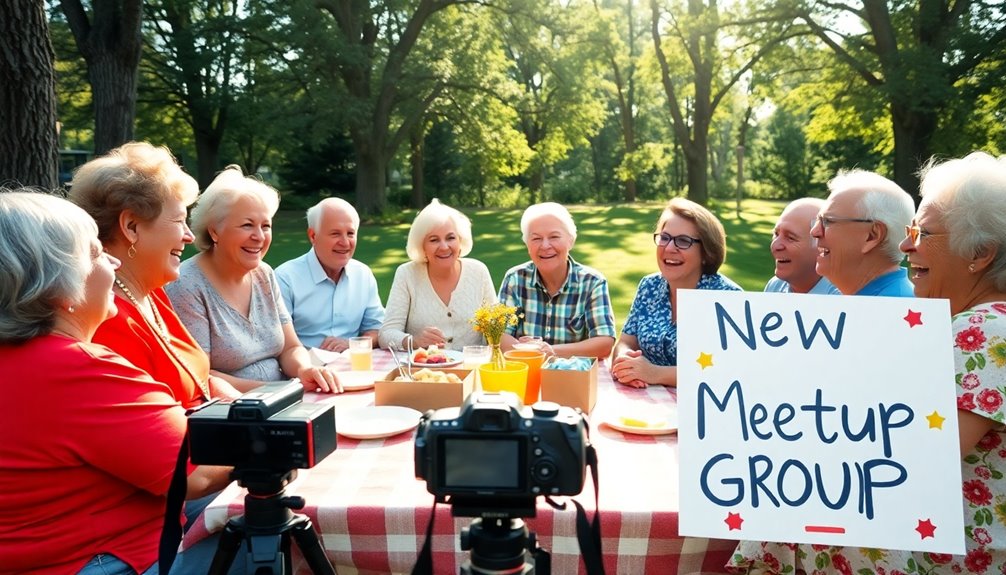
Starting a new Meetup group can be an exciting way to bring like-minded individuals together around a shared interest.
When I decided to create the Pompano Beach Senior Swimmers group, I wanted to connect with others who enjoy ocean swimming. I crafted a clear description and set a welcoming tone for potential members. Imagination played a key role in shaping our group's vision, helping us envision the community we wanted to build. Planning ahead for our meetups also helped to avoid unexpected weather issues, as meteorologists recommend considering conditions before scheduling outdoor activities. Additionally, I focused on goal-setting to define our group's objectives and keep members motivated. Understanding the importance of self-regulation can enhance our group's dynamics and support individual growth.
Initially, I saw interest, but weather delays postponed our first meetup. It's important to remain patient; building a community takes time.
I encouraged members to share their ideas for activities, fostering engagement. By creating a space for individuals with similar passions, I found not only potential friends but also a sense of purpose. Engaging in such activities can also lead to mental clarity as shared experiences help enhance emotional well-being.
If you have a unique interest, don't hesitate to start your own group!
Positive Social Interactions

Creating positive social interactions through Meetup can transform your social life.
I've experienced firsthand how engaging with different groups fosters connections that uplift and inspire. Here are some ways Meetup enhances social interactions:
- Diverse Interests: You can find groups that cater to various hobbies, ensuring you'll meet like-minded individuals. Engaging in activities with others can also enhance emotional well-being, especially for those dealing with health challenges. Participating in group activities can also provide mood enhancement through shared enjoyment. Additionally, engaging in activities can promote social development, contributing to a richer social experience. This is similar to how social interaction is crucial for mental stimulation in pets, like hamsters.
- Inclusive Environment: Most groups welcome everyone, making it easy to break the ice.
- Shared Experiences: Participating in events fosters camaraderie and shared memories.
- Friendship Building: Regular meetups help deepen connections, turning acquaintances into friends.
I've found that the more I engage, the more fulfilling my social life becomes. Additionally, understanding the importance of effective communication strategies can further enhance relationships formed through these interactions.
Upcoming Events and Resources
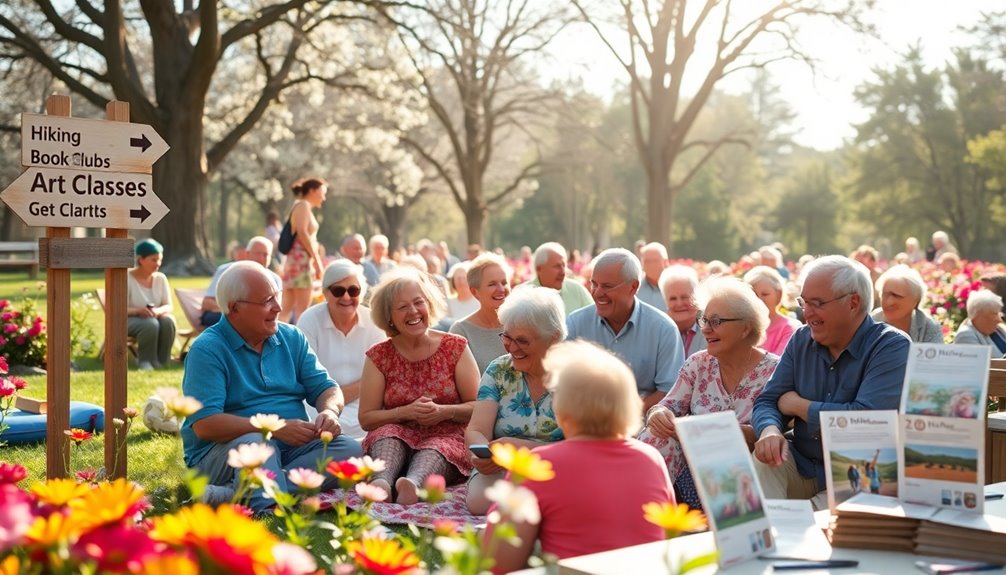
Meetup offers a variety of upcoming events and resources that can greatly enrich your social experience.
I've found that staying engaged with the platform's newsletters keeps me informed about local gatherings and activities tailored to my interests. Whether it's a themed dinner, a book discussion, or a creative workshop, there's always something happening nearby. Engaging in these activities can also provide social skills development through interactions with others. Additionally, participating in group activities can foster community connections, which are vital for emotional well-being. These events often encourage continuous learning by providing new experiences and insights. Music activities, for example, can enhance cognitive function and provide a unique way to bond with others.
I appreciate the online classes available through Senior Planet, covering topics that spark my curiosity and help me develop new skills.
These resources not only provide opportunities to meet new people but also enhance personal growth. Cookie preferences can also be customized to improve your online experience while exploring these resources.
I encourage you to explore what's available in your area; you might just discover a community waiting for you to join!
Health and Fitness Activities
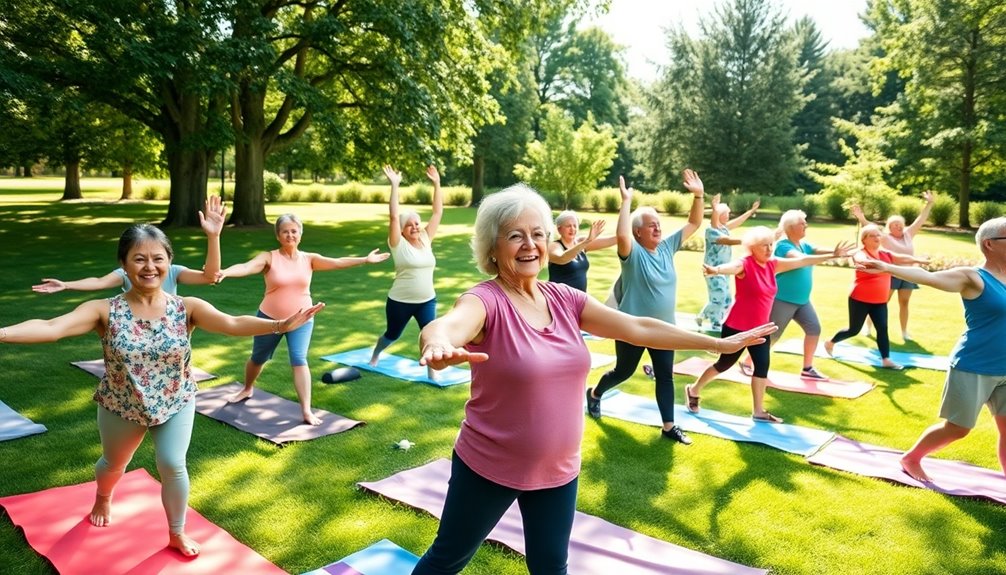
When it comes to health and fitness activities, I've found that Meetup offers a fantastic way to connect with others who share similar wellness goals.
I've participated in various groups that focus on different aspects of health, and each one has been a rewarding experience. Here are some activities I've enjoyed:
- Chair Yoga: Great for improving flexibility and relaxation.
- Morning Stretch: Energizing short sessions that kickstart the day.
- Fit Fusion Workout: A blend of cardio and strength training for all levels.
- Qigong Flow: Balancing mind and body through gentle movements. Engaging in these activities can also enhance mental clarity, which is essential for overall well-being.
Joining these groups not only keeps me active but also fosters new friendships, creating a vibrant social life centered around health and well-being. Additionally, engaging in these activities can lead to improved respiratory health and overall wellness, highlighting the importance of maintaining good indoor air quality. Moreover, the sense of community that emerges from participating in these groups enhances motivation and accountability, making it easier to stick to health goals. As we support each other through various challenges, the bonds we form often extend beyond the activities themselves, leading to deeper, more meaningful relationships. In this context, one could even argue that the concept of “friends with benefits explained” might apply, as these friendships not only enrich our social lives but also contribute positively to our health journeys.
User Feedback and Community Insights

Participating in health and fitness activities through Meetup has opened up a wealth of insights from fellow users about their experiences.
I've noticed many members sharing their challenges and triumphs, which creates a supportive atmosphere. Users often express their desire for connection, highlighting how these activities help combat feelings of isolation.
Feedback reveals a common struggle in finding groups that fit specific interests, yet there's a strong encouragement to keep exploring. Many have been inspired to start their own groups, fostering community around niche activities.
The open dialogue in comments showcases the genuine need for social interaction, proving Meetup is more than just an app; it's an essential tool for building friendships across various demographics.
Frequently Asked Questions
How Do I Change My Meetup Profile Settings?
To change my Meetup profile settings, I navigate to my profile, select "Edit," and adjust my preferences. It's straightforward, and I can easily update my interests, notifications, and privacy settings to suit my needs.
Can I Create a Private Meetup Group?
I could create a private Meetup group in a heartbeat, turning my living room into an exclusive haven for like-minded souls. Just set the privacy settings, and voilà—my cozy community awaits!
Are There Age Restrictions for Joining Groups?
There aren't strict age restrictions for joining groups on Meetup. I've seen people of all ages participate. It's about finding a community that shares your interests, regardless of age. Just plunge in!
How Do I Report Inappropriate Behavior in a Group?
If I encounter inappropriate behavior in a group, I report it directly to the organizer through Meetup's messaging system. It's crucial to address these issues promptly to maintain a positive and safe environment for everyone.
What Happens if a Meetup Is Canceled?
When a meetup's canceled, it feels like a balloon popped—deflated and disappointing. I usually check for reschedule notifications, stay engaged with the group, and keep my spirits up until the next gathering happens.
Conclusion
In just a few months, Meetup transformed my social landscape, turning what felt like an isolated existence into a vibrant tapestry of connections. For instance, I met a fellow book lover at a local café who introduced me to a poetry reading group. This simple encounter blossomed into a close friendship, proving that the right community can spark joy and creativity in unexpected ways. If you're seeking connection, don't hesitate—dive into Meetup and discover your own adventure!



